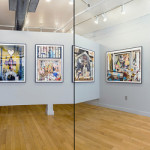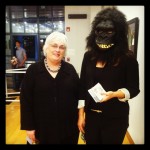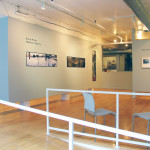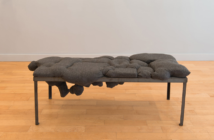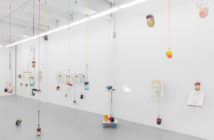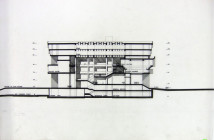Ten years ago, Arlette Kayafas opened a photography gallery on 450 Harrison Avenue (Thayer Street entrance) becoming what Big Red & Shiny contributor Robyn Day calls, the "Thayer Street patron saint of fine art photography." Aside from celebrating the 10th anniversary of the gallery, April has been a busy month for Arlette who is also the guest-curator of an exhibition on the photography of Jules Aarons, now on view through August 03, 2013 at the West End Museum in Boston.
To celebrate the occasion on Saturday April 20th, artists, curators, collectors, critics, and everyone in the Boston arts scene are all invited to stop by the gallery beginning at 5:30PM for champagne and cake. I asked Arlette five questions about her ten years in SoWA and what the future holds for Gallery Kayafas. For background on this short interview, read Charles Giuliano'sessay on Arlette Kayafas published in the June 13, 2007 Journal issue of Big Red & Shiny. In the essay, among the many things covered, Arlette discusses the Boston gallery scene and her passion for collecting photography.
****
| "The experience, although it sounds cliché, changed my life — gave me a new energy — and challenged me. It was, and is still exciting each day I unlock the door." |
Anulfo Baez: In your first exhibition in 2003, you showed the photographs of Ezra Stoller as well as work by Eric Lewandowski. Now to celebrate the 10th anniversary of Gallery Kayafas you're showing a selection of photographs by Aaron Siskind and Robert Richfield's "Perpetuidad," a body of work that explores cemeteries and memorials in Mexico. Tell us about your choice of Richfield's photographs to mark the 10th anniversary of the gallery.
Arlette Kayafas: When I started to think about the 10th year, lots of feelings came to the forefront: Aging, celebrating all stages of life, art as a life force and how quickly 10 years can pass. I had already decided to show Aaron Siskind. Aaron was an intimate friend and he and Gus worked closely together until Aaron’s death. My second son is named for Aaron. Robert and Gus are contemporaries. They were at RISD for graduate school and both very close to Aaron. Robert’s newest series, Perpetuidad, are large color images of Columbarium in Mexico. While there is a deep sadness in the finality of death, these images show an ongoing connection and celebration of the life lost.
It was also a good balance in processes: black and white gelatin silver; large color archival pigment prints. It was a perfect pairing on many levels.
AB: What are some of your most memorable moments from the last ten years of being in SoWA?
AK: Over the past decade there have been many, many moments that make me stop and think, this is why I do this. The people I meet enrich my life daily. And since I only show work I would own and add to our collection, I’m with beautiful objects daily.
In 2004, just one year open, the democratic convention was scheduled to take place in Boston. I decided to show the photographs of George Butler. He and John Kerry have been friends since high school and I knew that George’s images would add to my political voice. The exhibit created a buzz and before I knew it, I received a call from the convention committee. They asked me if I would be willing to do a visual (photographic) biography of John Kerry. I, of course, said yes! I had the second floor right at the top of the escalators. Both sides: I began with images from high school up to and including some of the currents images that were in the press. I was the most proud of my 3 walls of images from Vietnam. I added text and maps, documented where he was wounded, had photos from others who were with him. News media often did their broadcast in front of the walls. But the "Swift Boaters" still had a voice.
I was there for each day of the convention — it was exhilarating and I realized that I could use the gallery and the work I show to change perceptions, generalizations, prejudices…or at least try. However, whatever went on the walls had to be more than just the message — images had to be beautiful (which is different for me than pretty) and they had to have an energy that kept you engaged. I feel that I have been successful in doing that.
AB: What has been the biggest challenge for Gallery Kayafas since 2003?
AK: The biggest challenge is always turning art, a person’s passion and vision, into a commodity. I remember when the first financial decline happened, people expected to get deep discounts. I had more than my share of conversations about protecting the artist’s integrity — an artist’s time and vision were not lessened in value because of the recession. It was a difficult line to walk.
AB: Have these ten years been everything you hoped for?
AK: Before opening the gallery, I managed the care of elderly women. I found that I was always suffering a loss. I decided I had to do something that would be a beginning, ongoing and more positive. The gallery idea just happened, literally, I woke up one morning and said to Gus, I want to open a gallery. He was very supportive — still is! Gus refers to himself as the "Art Donkey" because he helps me move the art!
I couldn’t have asked for more. (well maybe more sales of course!) The experience, although it sounds cliché, changed my life — gave me a new energy — and challenged me. It was, and is still exciting each day I unlock the door. I have made life long friendships. My artists are very important to me and I find they become close friends and members of the family.
AB: What's in the works for Gallery Kayafas?
AK: I recently hired Stephanie Dvareckas as my assistant. She graduated from MassArt where she managed the Godine Family Gallery. We work well together — share the same values, standards and commitment to artists as well as the collector and community.
Working with Stephanie has freed me up to get more things in the works and with her help, we are launching a new web site by the end of the month. A new feature that we are both excited about, "Out of the Frame", will be an online exhibition space. There are so many great artists without real estate. This will provide the opportunity and space for the gallery to show more work. It will be open to media other than photography but will still focus on the art of photography.
- Courtesy of Gallery Kayafas
- Arlette Kayafas with one of the Guerrilla Girls in September 2012. Courtesy of Gallery Kayafas
- Courtesy of Gallery Kayafas



